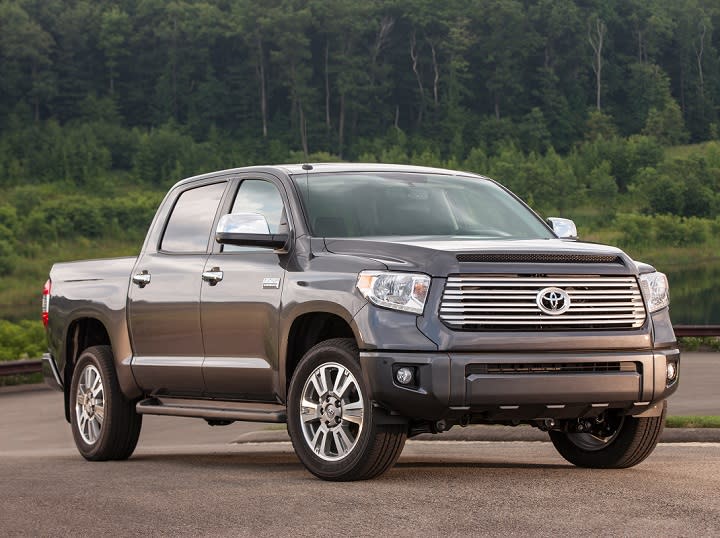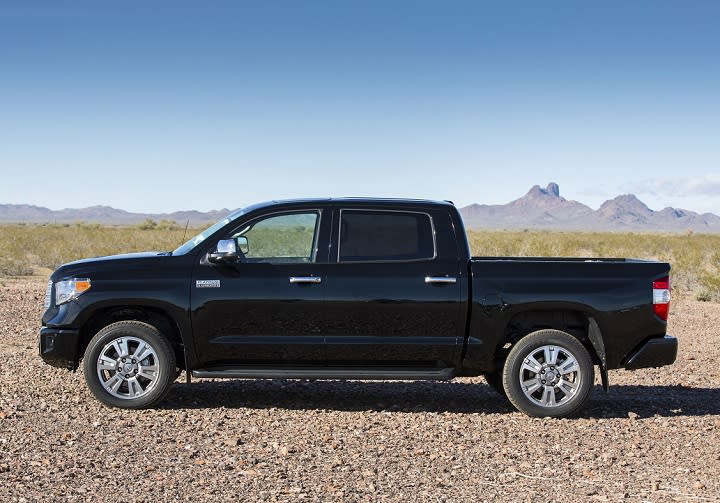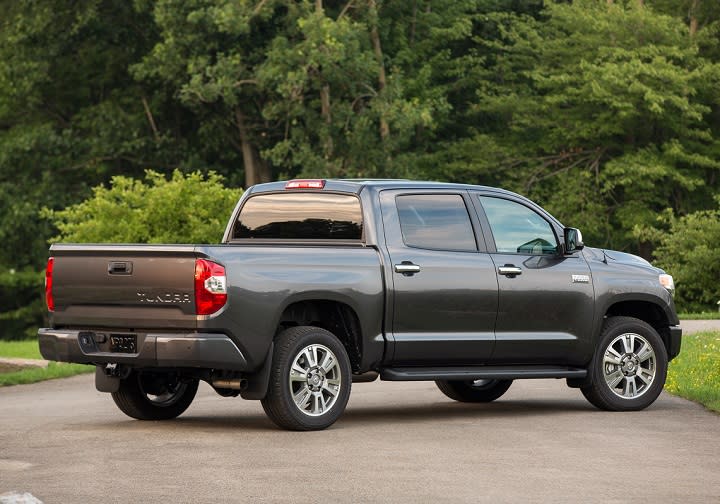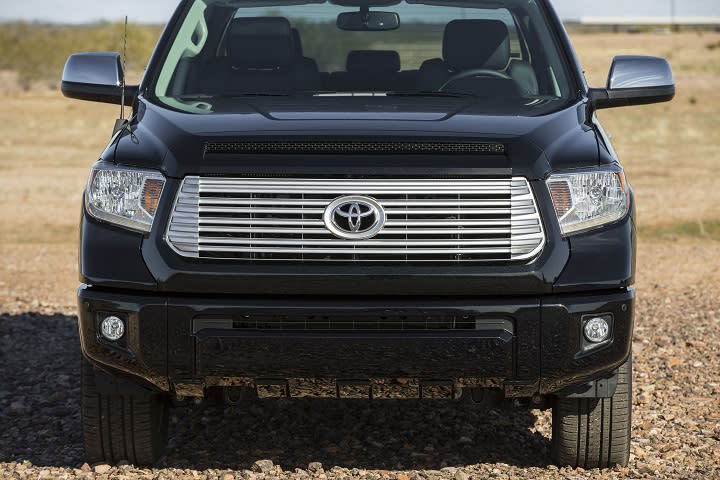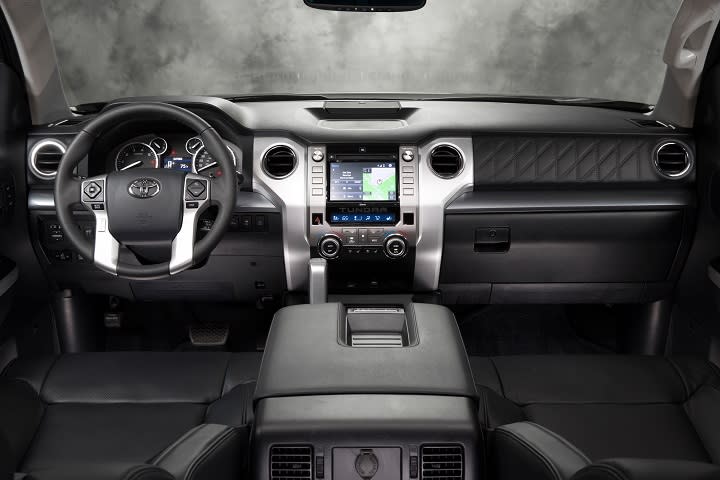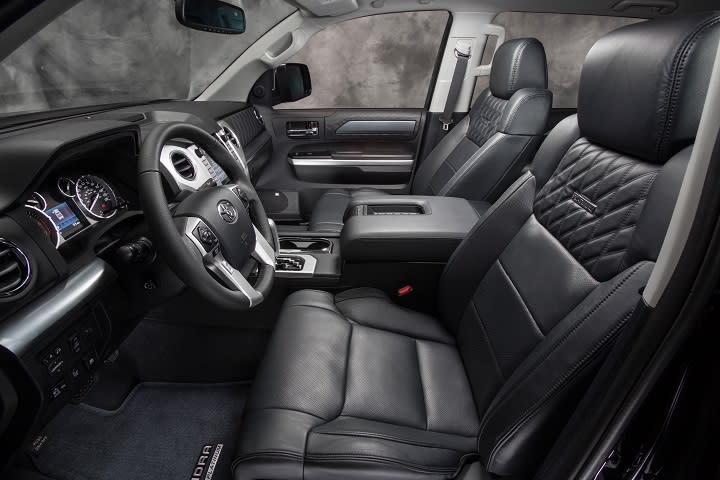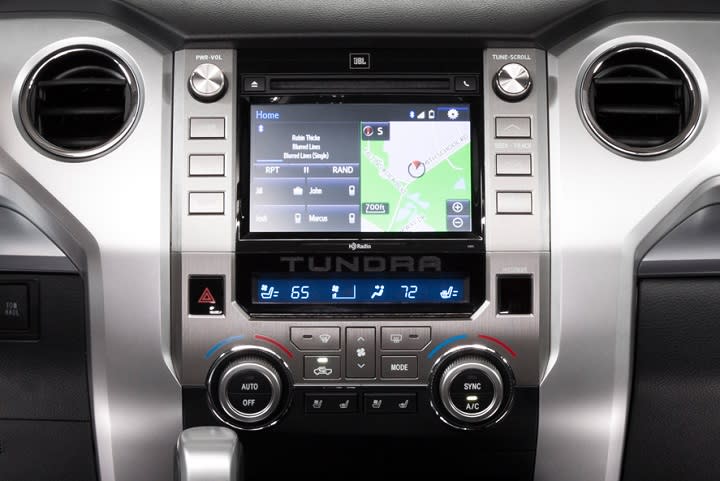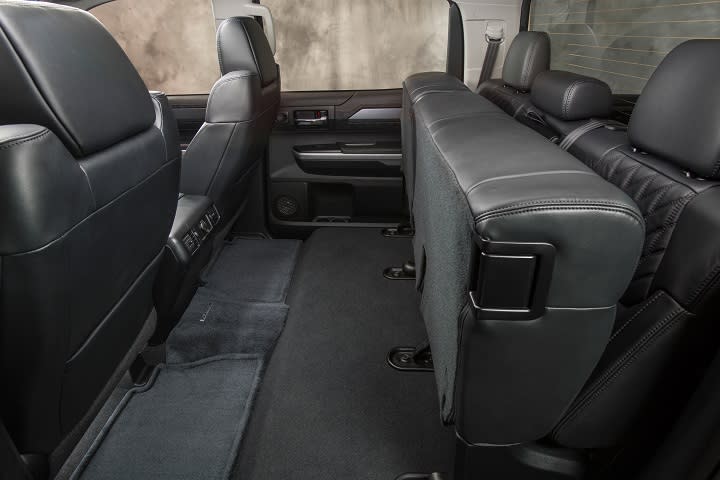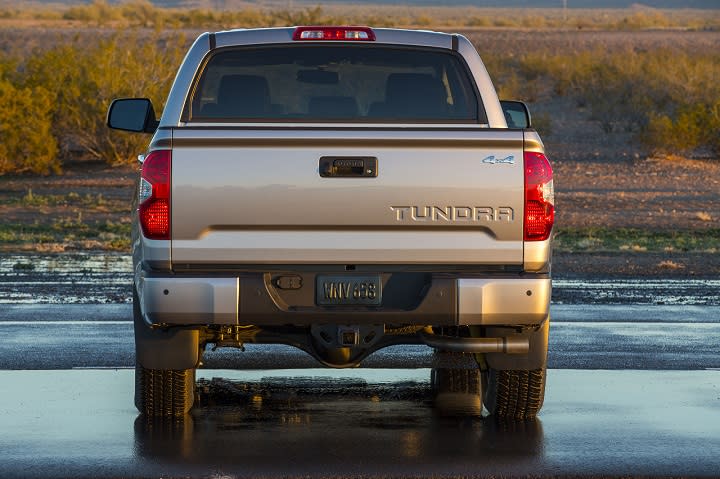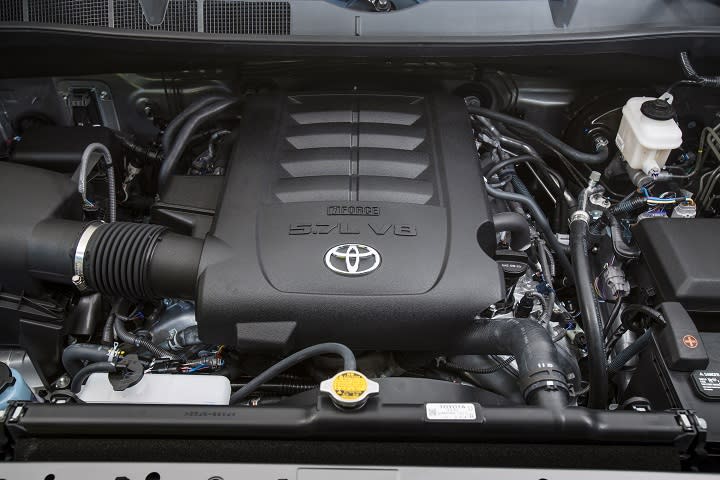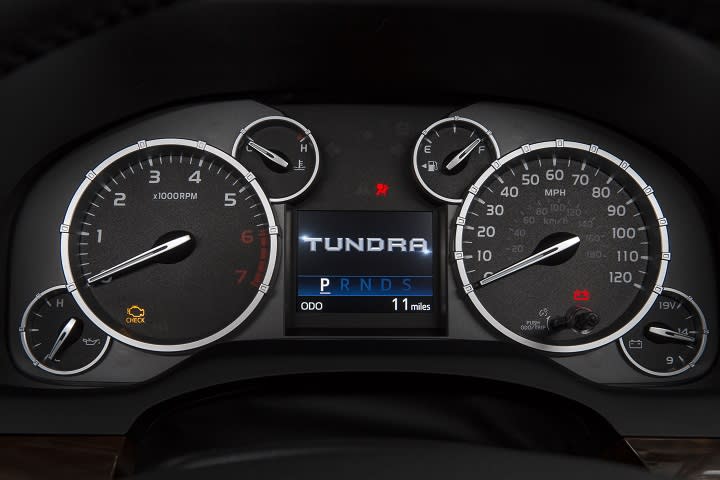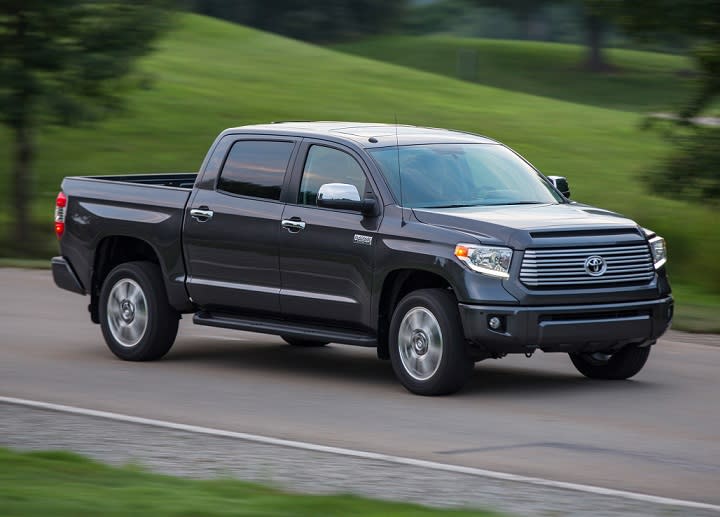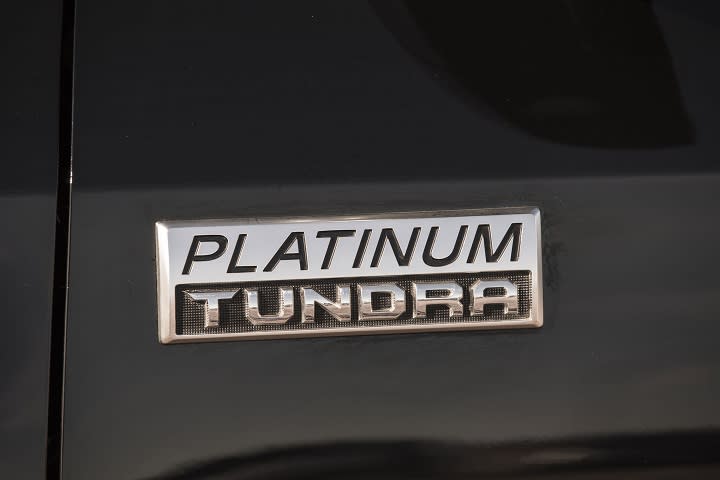PowerSteering: 2017 Toyota Tundra Review
Body Style:
Abstract:
The Tundra is older than any full-size pickup from any competing automaker, but it remains a stout, robust, ready-to-work Toyota truck that can tackle a variety of tasks.
Year:
2 017
2017 Toyota Tundra Platinum front quarter right photo Introduction
Fittingly, I tested the 2017 Toyota Tundra during the same week that President Trump was promoting “Made in America” products. Designed and engineered in California and Michigan, and built in Texas, the Tundra is more “American” than any full-size pickup from Chevrolet, GMC, or Ram, according to American University’s Kogod Made in America Index.
On an unrelated note, the Tundra is also older than any full-size pickup from any competing automaker. The current model arrived for the 2007 model year, and though it received a freshening for 2014, today’s Tundra is essentially the same vehicle that it was a decade ago.
Because of its age, it can’t tow as much weight as the competition, and it isn’t as efficient with fuel. But it remains a stout, robust, ready-to-work Toyota truck that can tackle a variety of tasks.
For this review, we evaluated a 2017 Tundra Platinum with a CrewMax cab style and 4-wheel drive (4WD). The price came to $51,425, including the $1,295 destination charge.2017 Toyota Tundra Platinum side profile photo What Owners Say
Before we discuss the results of our evaluation of the 2017 Tundra, it’s helpful to understand who buys this large light-duty pickup truck and what they like most and least about it.
Compared with the Large Light Duty Pickup segment, slightly more Tundra buyers are women (10% vs. 9%), they’re younger (median age of 50 vs. 56), and they are just a little bit wealthier (median annual household income of $103,831 vs. $102,974). Also, more Tundra buyers are members of Gen X (those born 1965 to 1976) or Gen Y (1977-1994) (51% vs. 45%).
Tundra buyers primarily identify themselves as price buyers (24%) followed closely by working utilitarians (23%). At the segment level, light-duty pickup buyers identify as practical buyers (32%) followed by price buyers (22%).
Only 48% of Tundra buyers claim that they prefer to buy a vehicle from a domestic company, compared with 81% of buyers in the segment. Only 40% say that fuel economy is their first consideration when choosing a new truck (vs. 50%). Tundra buyers are also less likely to pay extra for a vehicle that is environmentally friendly (39% vs. 46%).
Comparatively speaking, styling is less important to Tundra buyers compared with the segment average, with 80% agreeing that they prefer a vehicle that stands out from the crowd (vs. 86%). Perhaps related to this sentiment, more Tundra buyers view a vehicle as just a way of getting from place to place (35% vs. 31%). In other respects, Tundra buyer sentiments align with light-duty truck buyers in general.
Buyers say their favorite things about the Tundra are (in descending order) the engine/transmission, exterior styling, interior design, driving dynamics, and visibility and safety. Buyers indicate their least favorite things about the Tundra are (in descending order) the climate control system, seats, storage and space, infotainment system, and by a massive margin, fuel economy.2017 Toyota Tundra Platinum rear quarter right photo What Our Expert Says
In the sections that follow, our expert provides his own assessment of how the new 2017 Tundra performs in each of the 10 categories that comprise the J.D. Power 2017 U.S. Automotive Performance, Execution and Layout (APEAL) Study.SM
2017 Toyota Tundra Platinum front photo Exterior
When Toyota updated the Tundra back in 2014, it went for a muscular and distinctive “big rig” appearance. Flared fenders, squared-off angles, an oversized grille, and lots of available chrome contribute to the truck-like look, as do bold 20-in. wheels installed on half of the available trim levels. A Baja racing-inspired TRD Pro version is also available, ready to rocket across the desert right off of the San Antonio assembly line.
Platinum trim brings body-color exterior detailing, and in combination with Magnetic Gray paint it tones down the Tundra’s glamour factor. In terms of its overall styling, I’d rate it mid-pack among its competitors.2017 Toyota Tundra Platinum interior photo Interior
If not for the test truck’s diamond-stitched leather seats with matching material on the dashboard, it would be extremely difficult for Toyota to justify the Tundra Platinum’s price tag. Otherwise, the acres of plastic make the cab look and feel inexpensive.
Controls are logically laid out, though some are quite a distance from the driver, and the knobs and buttons are large enough that people wearing gloves can operate them.2017 Toyota Tundra Platinum front seats photo Seats
Big, wide, and comfortable, the Tundra’s seats are pleasing. Unfortunately, the padding for the center console armrest and the upper door panels is unexpectedly thin.
Rear-seat passengers should utter no complaints about comfort. The CrewMax model’s back seat is oversized, supplying plenty of room for three adults or lots of locked and covered storage space.2017 Toyota Tundra Platinum infotainment and climate control system photo Climate Control System/Infotainment System
Climate Control System
The Tundra Platinum includes an automatic, dual-zone climate setup offering oversized temperature control knobs and logical arrangement of secondary function buttons. White-on-gray markings may not provide enough visual contrast for some people, though, especially on sunny days.
Hot temperatures were the norm during the time I tested the Tundra, and the air conditioning system blew ice-cold air almost immediately upon starting the engine.
Infotainment System
Given the infotainment system’s small, glare-ridden display screen, tiny radio station pre-set buttons, and lack of Apple CarPlay and Android Auto smartphone projection, it is not at all surprising that this component is one of the least favorite things about the Tundra as reported by buyers. Furthermore, it doesn’t offer a Wi-Fi connection, or any subscription service packages aside from satellite radio.
Clearly, it is time for this aged version of Toyota’s Entune infotainment system to hit the road, Jack.2017 Toyota Tundra Platinum rear seat photo Storage and Space
Overall, the Tundra feels spacious, oversized even. However, by modern full-size pickup truck standards, the Tundra’s interior storage spaces fall short. In particular, the center console area is space inefficient, featuring 3 cupholders and an oversized shifter but only two small and shallow trays for holding items.
Equipped with rear seat cushions that fold up, the Tundra CrewMax supplies plenty of locked and covered cab space behind the front seats, combined with a 5.5-ft. cargo bed accessed via an easy lower-and-lift tailgate.2017 Toyota Tundra Limited rear photo Visibility and Safety
Increasingly, the Tundra is getting left behind other full-size trucks when it comes to driver-assistance and collision-avoidance technologies.
Aside from a reversing camera, front and rear park-assist sensors, and a blind-spot warning system with rear cross-traffic alert, the Tundra is not available with increasingly common modern safety systems. This truck’s buyers can’t even get Toyota’s Safety Connect subscription services, which includes automatic collision notification and SOS emergency calling.
Outward visibility is fine, though the reversing camera and parking sensors come in handy on a regular basis. This truck does take some acclimation time, though, especially with regard to parking.
The Tundra’s crashworthiness isn’t terribly impressive, either. The federal government’s National Highway Traffic Safety Administration (NHTSA) gives the Tundra a 4-star (out of a possible 5) rating, mainly due to 4-star scores for both the driver and front passenger in a head-on collision. Choose 4WD to reduce the risk of rollover. The rear-drive Tundras are rated 3 stars in this regard, while the 4WD models get 4 stars.
Meanwhile, the Insurance Institute for Highway Safety (IIHS) rates the Tundra as “Marginal” in the small overlap offset frontal crash-test and gives the truck an “Acceptable” rather than “Good” rating for roof-crush strength. The headlights are rated “Poor.”2017 Toyota Tundra Limited engine photo Engine/Transmission
Though it is thirsty, I like Toyota’s 5.7-liter V-8 engine. Thanks to 381 horsepower at 5,600 rpm and 401 lb.-ft. of torque at 3,600 rpm, it’s got impressive thrust, and it sounds terrific. The 8-speed automatic transmission is well matched here, and when you need maximum power it eagerly kicks down to deliver. It also holds lower gears for ascending and descending mountain grades.
Toyota was first to adopt official SAE J807 towing standards, but now that all trucks adhere to them, the Tundra’s 10,500-lb. limit comes in a ton short of the segment leader. Maximum payload of 2,080 lbs. comes up short by more than half a ton. In this respect, the Tundra clearly shows its age.2017 Toyota Tundra Limited instrument panel photo Fuel Economy
Not only does the Tundra fall short in terms of towing and hauling, it gets abysmal gas mileage. According to the EPA, the test truck should have returned 15 mpg in combined driving. On the test loop, it got 13.8 mpg, and after a week of driving had mustered no more than 13.5 mpg.
2017 Toyota Tundra Platinum front quarter right motion photo Driving Dynamics
Out on the road, sharper impacts reveal the Tundra’s decade-old age in the form of structural shudder. It is faint, but perceptible, especially in comparison to, say, a Ford F-150. Nevertheless, like other full-size 4WD trucks, the Tundra pummels lousy pavement into submission. The plastic-laden cabin does rattle a bit over the worst surfaces.
On center, the steering is fine, resolutely pointing the truck down narrow, arrow-straight farm roads with an expected bit of play. Braking is stout, the pedal feeling completely natural underfoot, and handling is decent, the truck carrying more speed than might be expected in gentle bends and well-banked curves.
That said, you still need to keep speed down in sharper, flatter corners. The tires aren’t up for having much fun, and the steering feels too light and eager to return to center. This rubbery feel to the steering wheel is the least pleasing aspect of driving the truck.
Off-road, the truck’s size limits capability more than anything else. The Tundra tackled a narrow trail lined by instantly flammable grasses, one that I took only because I knew I wouldn’t need to execute a turn or reverse at the end. It also effortlessly traversed deep ruts and descended an angled dirt grade with a rut at the bottom. Engaging 4WD is as simple as twisting a knob.
One of the Tundra’s unique features is a rear window that powers down, creating a huge open space to the cargo bed. When you lower the rear window, open the sunroof, open all of the windows, and cruise along the beach, the Tundra feels much like a convertible.2017 Toyota Tundra Platinum badge photo Final Impressions
It is time for Toyota to completely redesign the Tundra. This full-size truck cannot match segment leaders in terms of towing, hauling, fuel economy, and safety ratings. It is also unavailable with a modern infotainment system, the latest in convenience features and technologies, and increasingly important driver-assistance and collision-avoidance systems. The cabin needs more storage and better materials, too.
Reliability is a Tundra highlight, and the truck comes with free scheduled maintenance for the first two years of ownership. Comfort is decent, the control layout is useful, and the air conditioning blows ice cold. I’m also a big fan of the power rear window.
Still, this handful of positive attributes cannot outweigh the lengthening list of negative attributes as the old truck continues to age.
Toyota Motor Sales, U.S.A. supplied the vehicle used for this 2017 Tundra review.
For more information about our test driver and our methodology, please see our reviewer profile.Additional Research:
Check this if this is NOT an Articles Listing Page:
New or Used:
New
Display Article Date?:
Fuel:
Article Is Flipbook:
Yes
Article Photo Gallery:
Photo Gallery: 2017 Toyota Tundra
Recall:

 Yahoo Autos
Yahoo Autos 
